Brook Trout Fishing In Rivers: Guide Tips and Tricks
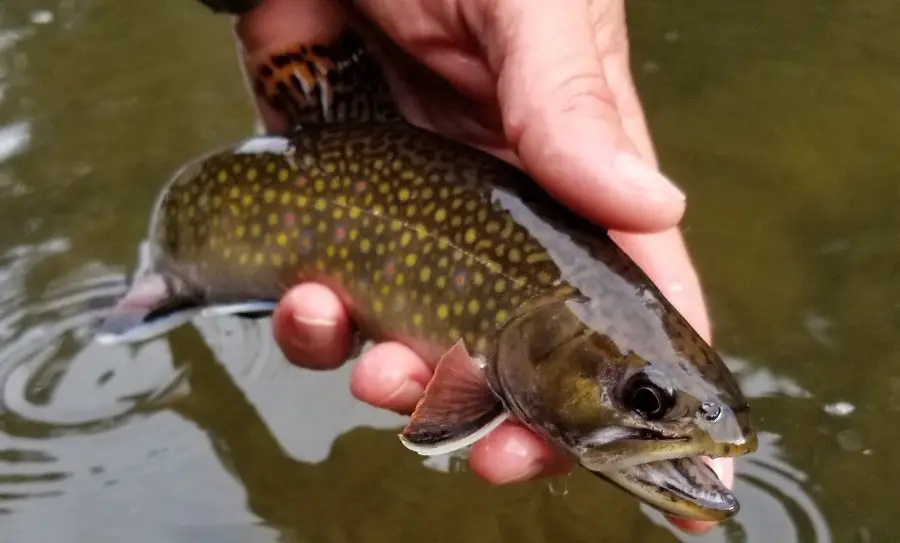
I still remember the first brook trout I caught over 35 years ago. Since then, I have guided and taught hundreds of anglers the many tips and tricks that I’ve learned fishing with other trout guides and spending thousands of hours on the water catching brook trout.
Brook trout fishing in rivers comes down to some simple things:
- Know where to fish: The brook trout is a freshwater fish native to Eastern North America. Anglers who want to fish for brook trout need to know where to fish for them.
- Use the right gear:
- Use the right bait:
- Use the right fishing method:
- Use the right setup:
- Get a great presentation:
Where Do Brook Trout Live?
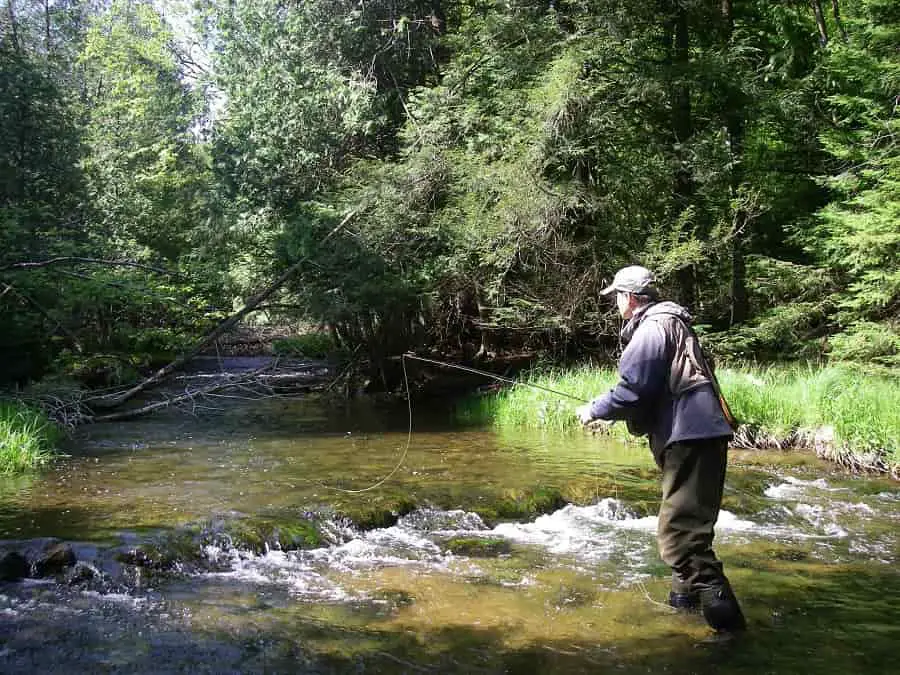
Brook trout can be found in ponds and lakes, but brook trout are prevalent in very cold streams and rivers.
Brook trout require cold, clean water. They are often found far up the rivers where the coldest water is.
Brook trout often find and use structure and deeper sections that may concentrate them.
River brook trout prefer headwater spring ponds and small spring-fed streams, riffles, runs, pools, and damned areas, but they can inhabit many different aquatic environments. They can live in:
- River and stream systems with cold water
- Small and large tributaries to the main river, as long as it’s cold
- Small ponds, often ones that are attached to a stream with an inflow and outflow
- Lakes: There are some lakes, especially in Canada, that have good brook trout populations, including massive lakes like Lake Superior.
- Oceans: Brook trout in oceans are rare, but the ones found close to shore are the so-called “salters” or “coaster brookies.”
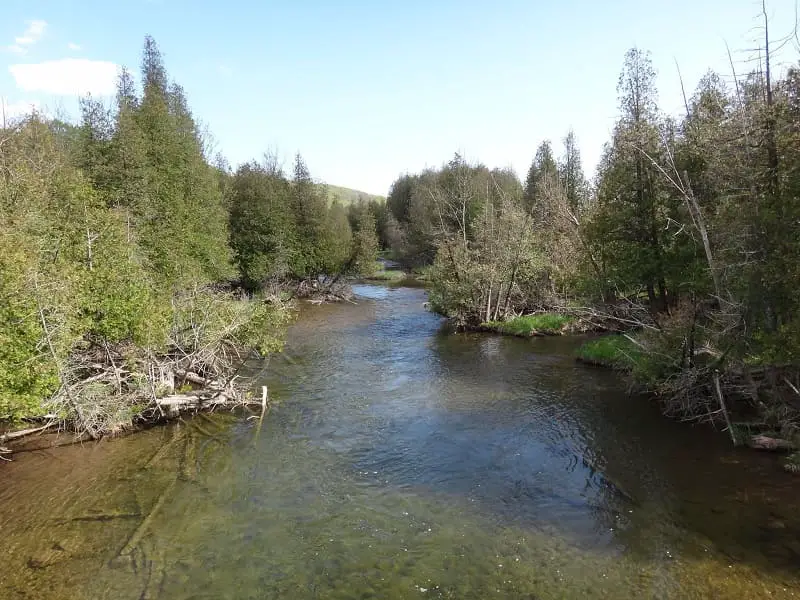
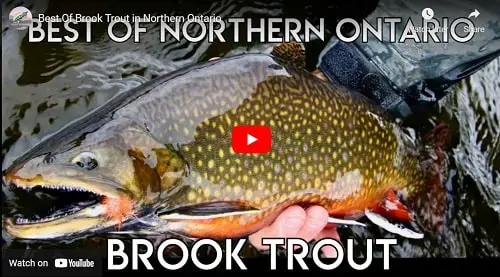
Many anglers claim that Northwestern Ontario’s Albany River watershed offers the best fishing for large brook trout, but there are many areas in Manitoba, Ontario, and Quebec that have world-class brook trout fishing.
What Do Brook Trout Eat?
Brook trout are opportunistic feeders, and they eat almost anything they find. They prefer aquatic insects living on the river bottom, but they will eat land insects that fall into the water, too.
Older brook trout eat larger invertebrates, such as snails and worms. If minnows or small fish appear as easy prey, brook trout will seize the opportunity and eat them. In fact some of the largest brook trout that I have seen tried to eat the five-inch brook trout that I or my clients were reeling in.
Most of my largest brook trout were caught on 3- to 5-inch streamer flies or crankbaits, which tell you how much they like baitfish and things like leeches.
Brook trout will also eat frogs and small mammals like mice, and some fly anglers will use large mouse patterns for big brook trout.
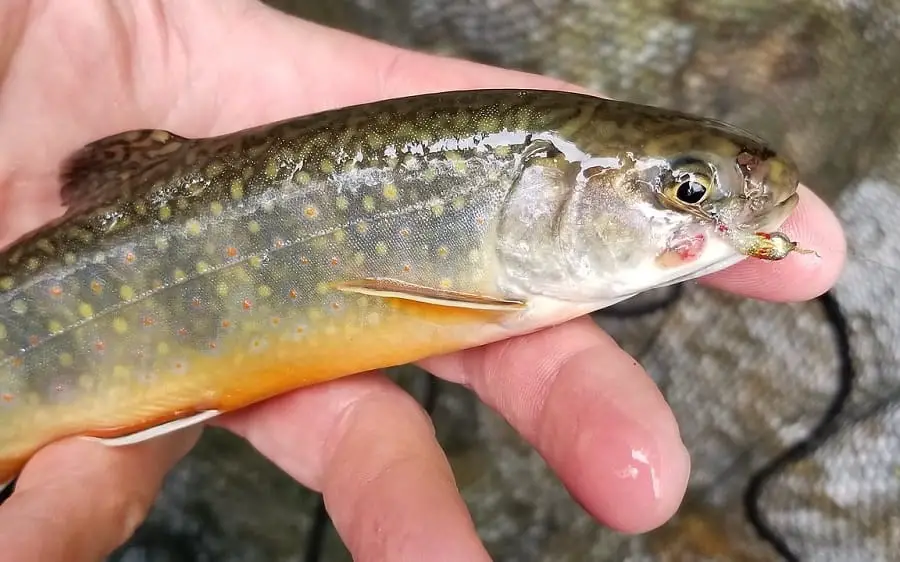
Finding Bigger Brook Trout
If you hope to catch a bigger brook trout, fish in areas that aren’t as heavily fished, or try finding brook trout in bigger rivers with abundant food sources.
I have a six-pound brook trout mounted on my wall (which belongs to and was caught by a good client of mine), and that brook trout came from a river that was about 12 -15 feet wide with an average depth of fifteen inches but it was also on private property where nobody else is allowed to fish, and because of that, there are lots of HUGE brook trout in that tiny river.
Other public sections on that same river have very few big trout because anglers harvest them, or pressure them into other areas.
Another client caught a 4lb and a 5-pound brook trout on another small stream that averaged 7 to 9 feet wide, and it was also on a section of that stream that nobody fishes. This shows that brook trout can get big even in small rivers as long as the conditions are good for them.
Larger rivers, lakes, and ponds often have bigger brook trout that can average over 15 inches long. Brook Trout living along the shores of Lake Superior can grow to be 24 inches long, and the record for this area is over 14 pounds.
As an example of the potential size of brook trout, the brook trout, which won the Minnesota state angling record, weighed 6 lbs 5oz (3 kg).
The biggest Brook Trout in the world weighs 14.5 lbs (6.6 kg) from the Nipigon River in Ontario, which is a massive and deep river that flows into Lake Superior and is where many large coaster brookies are caught.
Northern Ontario and Quebec, Canada, are known for bigger and deeper brook trout rivers where 4 to 5-pound brook trout are common.
Find Cold Water
As a river guide who spends a lot of time guiding brook trout, I have found that when the water hits 66F or above, it’s not worth fishing for brook trout as they seem to be stressed and completely stop feeding.
Best Fishing Methods
Consider one of the following methods:
- Fly Fishing – This is a very effective method that I use most of the time in rivers, but it is also good in lakes and ponds.
- Spin fishing with lures – Small lure fishing can be effective anywhere that brook trout reside.
- Float fishing – I use this method on bigger brook trout rivers or in deeper pools.
As a river guide, adapting to the conditions is very important if I want to keep my clients catching brook trout.
Fly Fishing For Brook Trout
With fly fishing, you can imitate all the aquatic insects found below the surface that trout love to eat. We call this Nymphing or nymph fishing. You can also imitate bugs on the surface, which is known as dry fly fishing.
You can also cast and retrieve streamer flies. Streamer flies imitate baitfish, leeches, frogs, and even mice. Often, streamers take the biggest brook trout.
The Best Equipment For Brook Trout Fly Fishing
The best rod for brook trout fly fishing is usually a 3-weight fly rod with a floating weight forward fly line. You could also use a rod as light as a 2-weight or even as heavy as a 5-weight rod.
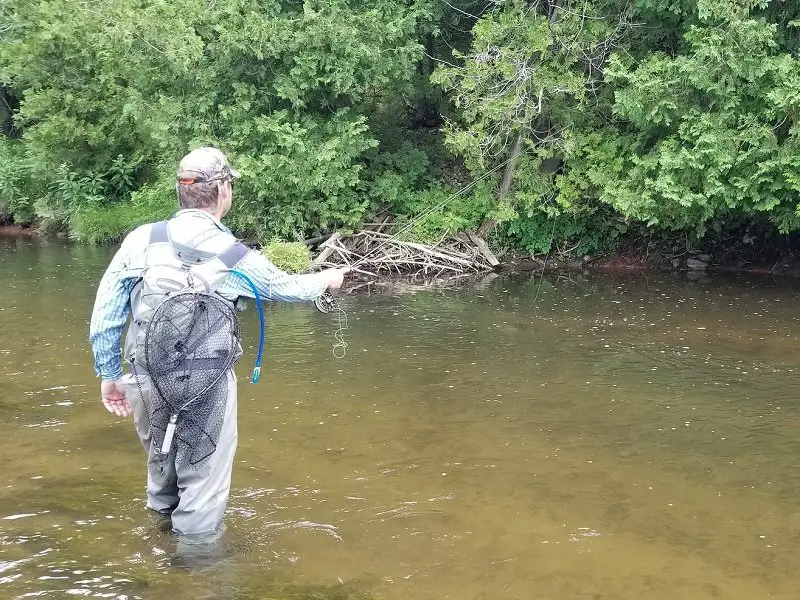
When nymph fishing, I use a 10-foot, two or three-weight rod.
You’ll want your fly to drop down to where brook trout are resting, which calls for a split shot weight or weighted flies.
Best Flies For Brook Trout
Depending on the season and the type of water you fish, you can use nymphs, wet flies, dry flies, or streamers. Either way, it is a good idea to have a good assortment of flies.
The list of suitable flies for brook trout fly fishing includes:
- Zonkers – Streamer – White is often my go-to color, but I have done well with black, olive, and yellow. Other colors should work.
- Woolly buggers – For Streamer or Nymph – Best in olive, black and white
- Bunny Leach Streamer – Best in olive, black and white
- Muddler Minnow: Great for all trout
- Marabou Muddler Minnow: See sizing for all flies below.
- Royal Coachman – Dry Fly – My favorite pattern for brook trout
- Royal Wulff – Dry Fly
- Humpy – Dry Fly – Yellow, red and orange bodies
- Terrestrials – Dry Fly or Nymph – Beetles, crickets, grasshoppers, and ants
- The Usual – Dry Fly – Works for most trout, and brook trout love it
- Adams – A great early season dry fly
- Caddis fly – Dry Fly
- Olive duns – Dry fly
- Walts worm and Sext Walts Worm – My hottest brook trout nymph in 2021
- Caddis Larva and Peeping Caddis– For Nymphing
- Blow Torch
- Prince Nymph
- Pheasant Tail Nymph
- Frenchie
- Midnight Intruder fly
- SOS Fly
- Sanjuan worm – One of my most productive flies, especially for big brook trout. My best colors are pink, brown, and red.
- Polish Pheasant Tail Nymph
- Surveyor Scud
- Pheasant tail and bead-head pheasant tail nymph
- Rainbow Warrior
- Mouse flies (for larger fish)
Fly Sizing:
- For nymphs and wet flies: I usually use sizes 14 and 16, but there are times when I will go one size bigger or smaller.
- Dry Flies: Most of my dry flies are size 12 to 16. Rarely do I need to go smaller unless they are keyed in on a very small hatch
- Streamer Flies: For small brook trout, 1 to 1.5-inch streamers are best, and for the bigger brook 14 inches trout, I have used flies up to 6 inches long; however, for most big brook trout, a 3 to 4-inch streamer is perfect.
Fly Colors:
I have done well matching the hatch. So when there are brown bugs in the water or on the surface, I use brown flies. However, it is not uncommon that I use an attractor-type fly like the SOS, Blow Torch, or the Rainbow Warrior fly.
Spin Fishing For Brook Trout
Spin fishing is a very common method that involves the use of spinning reels and a short light or ultra-light rod.
With spin fishing, you can fish baits or flies below a float, known as float fishing, which I will discuss below.
You can also fish bait or fly without a float with a method called Bottom Bouncing. I use bottom bouncing in shallower water where floats don’t work well. Bottom bouncing is an excellent method in fast water, rapids, and is often the best method in pocket water.
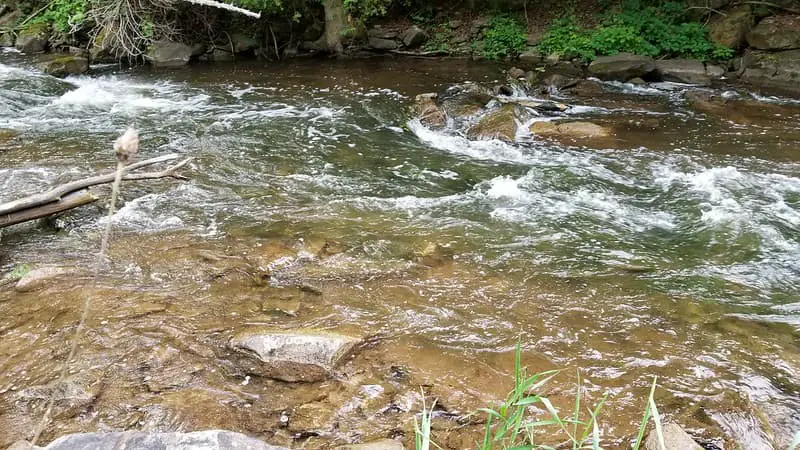
Spin fishing is also used when casting lures for brook trout in rivers. Cast the line across the river and slowly retrieve it, allowing the current to impart action to the lure.
The best equipment for brook trout spin fishing
For brook trout, a reel size of 10 to 20 is perfect when combined with an ultra-light rod. For heavily wooded areas where it’s hard to cast, a 5 to 6-foot rod is a good choice. On larger rivers that are more open for casting, I prefer seven to 9-foot rods.
For best results with lures in bigger open water, the rod you choose should be at least seven feet long. The longer rod will improve your casting distance and turning power. You should stick to the slower action rods since they are usually more sensitive.
I discuss river rods in more depth on my page, Best River Rods.
Best Line For Brook Trout
For most brook trout streams, a four to six-pound high-quality monofilament line is a good option. For larger brook trout in bigger rivers, and when using lures, a 6 to 8-pound fluorocarbon line or braided line of 10 to 20 pounds.
There are three types of lines I recommend on my page The Best Fishing Line For Trout: What The Guides Use.
Best Lures For Brook Trout
For best results, use lures that match the size of the fish that you are fishing for. If the river is full of six to ten-inch brookies, use a very small lure. If you have a river that holds brook trout over five pounds, you could use lures three to four inches long.
Here is the list of lures that are suitable for brook trout:
- Blue Fox spinners – Sizes 1 to 3 for small brook trout, and sizes 3 to 5 for large brook trout
- Panther Martin spinner
- Roostertail spinner
- Mepps Aglia spinner
- Krocodile spoon
- Kastmaster spoon
- Flatfish and Kwickfish
- Phoebe spoon
I discuss the best lures for all types of conditions and how to cover the water like an expert in my article Lure Fishing For Trout.
Float Fishing For Brook Trout
Float fishing is one of the best techniques for catching Brook Trout in rivers that are 3 to 10 feet deep. Float fishing works best in deeper, slow-moving pools or anywhere there is enough depth and length for a float and bait to drift naturally.
Not all rivers have suitable fishing spots for float fishing, so knowing other methods like Bottom Bouncing is advised.
When float fishing, you present the bait below a float or bobber; unfortunately, if you do this in water that is too shallow and clear, the float could spook the trout.
5-foot and 6-foot ultralight rods are an excellent choice for small streams. I recommend the St. Croix Premier. In rivers over 20 feet wide, you should best use an 8’6″ light trout rod.
I discuss all the best float fishing methods, leader setups, and how to do it better on my page, Float Fishing: River Guide Methods And Tips.
Best Bait For Brook Trout
The choice of bait depends on the water you are fishing and the time of the year.
You should try one of the following:
- Worms – live or plastic worms like the Berkely warms in pink, brown, and red are my favorites. See: Fishing With Worms For Trout and Steelhead: 10 Guide Tips
- Spawn Sacks- Small spawn sacks about the size of a dime or a pea are my favorite – Spawn Bags – Guide Secrets For More Trout And Steelhead
- Beads – See Bead Fishing For Trout – Easy Guide Secrets
- Flies – Flies can be fished using the bottom bouncing method or under a float – See How To Fish Flies With Spinning Gear
Berkley Trout Worms
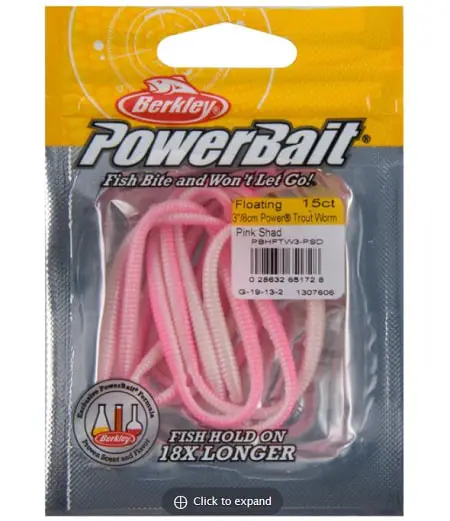
Berkley Gulp Earthworms / Red Wigglers
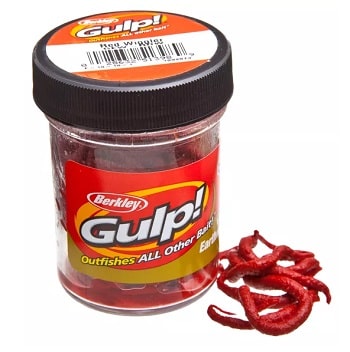
Berkley Gulp! Alive! Angle Worms
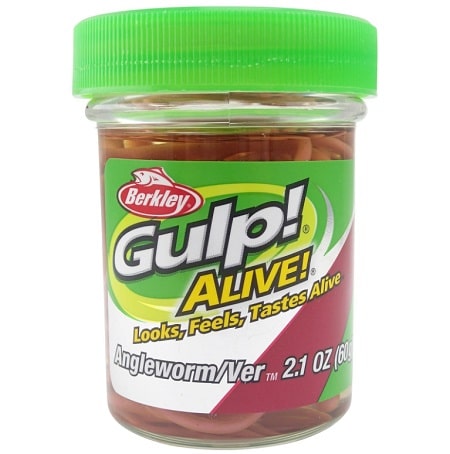
Fishing Tips
Brook Trout are fragile fish, and you should keep this in mind if you prefer to do catch-and-release fishing. Here are some practical tips that will help you keep your fish unharmed:
- Never fish for brook trout if the water is near or above 67 degrees. In the summer, fish only in high mountain streams early in the morning.
- Your hands should be wet when you touch the brook trout, or you risk rubbing off their protective layer of slime.
- Never put your fingers in the brook trout’s gills – they are highly sensitive!
- Do not squeeze the fish. Gently cradle the fish, allowing it to distribute its weight on your hands.
- Try to land the brook trout in minimal time to minimize the stress it feels.
- Use barbless hooks.
- Use a net, or at least keep the brook trout in the water while you unhook it. Check out 5 Best Trout Nets
- Never pull the brook trout out of the water by holding the line.
- Every second the brook trout spends out of water increases the chances it will die. If you want to take a photo holding your brook trout, make sure everything is ready before taking the fish out of the water.
Brook Trout Fishing In Different Seasons
Brook trout actively migrate up and down the rivers and streams in search of adequate conditions throughout the year.
Spring Fishing For Brook Trout
In the spring, the Brook Trout should be rather easy to find in much of the river, but this is also when I tend to find more and bigger brook trout further down the river from where they hold during the summer. They migrate down the river to bigger pools and deeper water where there is more food and where they can survive the winter.
In early spring, I fish deeper and slower since the brook trout may be less active in the cold water. As the water warms, dry flies will become a good option if you see bugs on the water.
Worms are one of my favorite baits in the spring.
Summer Fishing For Brook Trout
In the summer, the water becomes too warm for Brook Trout, and they start to migrate upriver to colder water. They will also search out cold water spring upwellings, cold water creek mouths that enter the main river, and cold tributaries to migrate up.
If you can find cold water surface fishing with dry flies and fishing flies, baits or lures below the surface can be effective.
Fall Fishing For Brook Trout.
At the beginning of the fall season, brook trout can be found in faster water either feeding or looking for spawning grounds. Therefore, in September and early October, try to find fast-moving riffles that are at least two feet deep.
As you approach the end of the fall season, move to the slow waters and deeper pools.
This is when there are fewer bugs on the surface, so nymph fishing, streamers, lures, and baits fished near the bottom work the best.
Winter Fishing For Brook Trout
In many areas, the season is closed to fishing, but some areas remain open and legal to fish for brook trout.
The winter fishing season on streams often lasts till late March, and this is the time brook trout are concentrated and is when you need to fish slowly.
If you are allowed to fish for brook trout, fish deeper pools and slow your presentation down as much as possible.
I also recommend using small baits and very small flies. Sometimes as small as size 18 to 20 midges or small stonefly patterns.
You should also avoid fishing first thing in the morning, which is when the water is coldest, and try late morning around 11 am to about 3 pm, which is when the water may have either stabilized or warmed a degree or two. Stable water temps and warming temps this time of year can make them active.
See my tips and strategies for trout fishing cold water on my page, Fishing In The Winter – Stay Warm With These 10 Tips.
You have just read the shortened and revised version. For the more in-depth and full version, check it out HERE.
Tight Lines,
Graham
